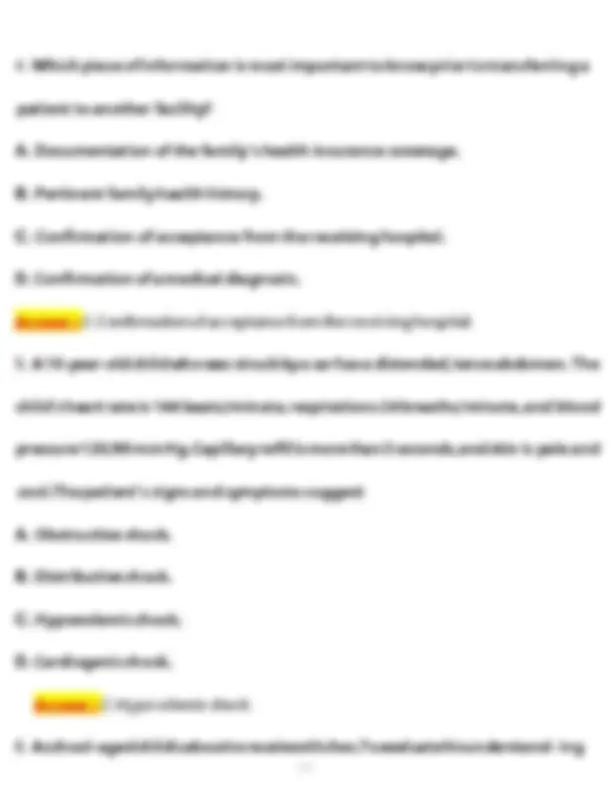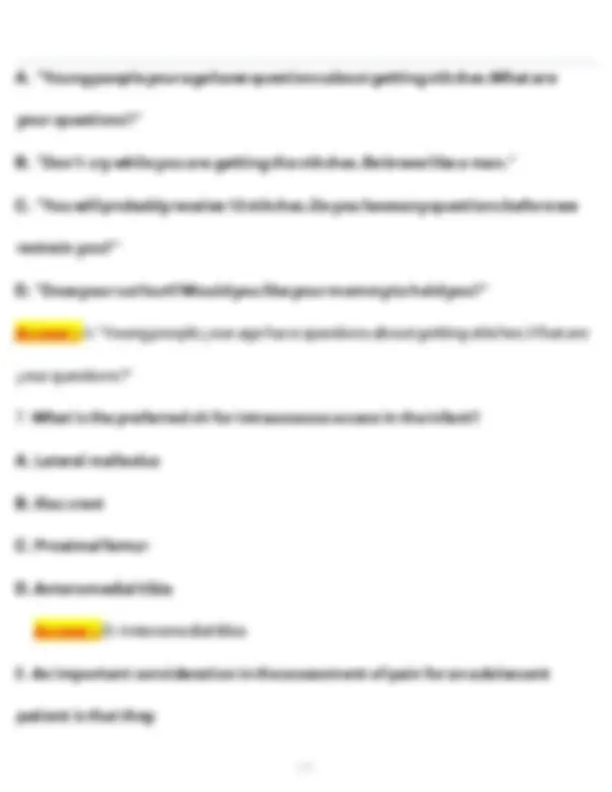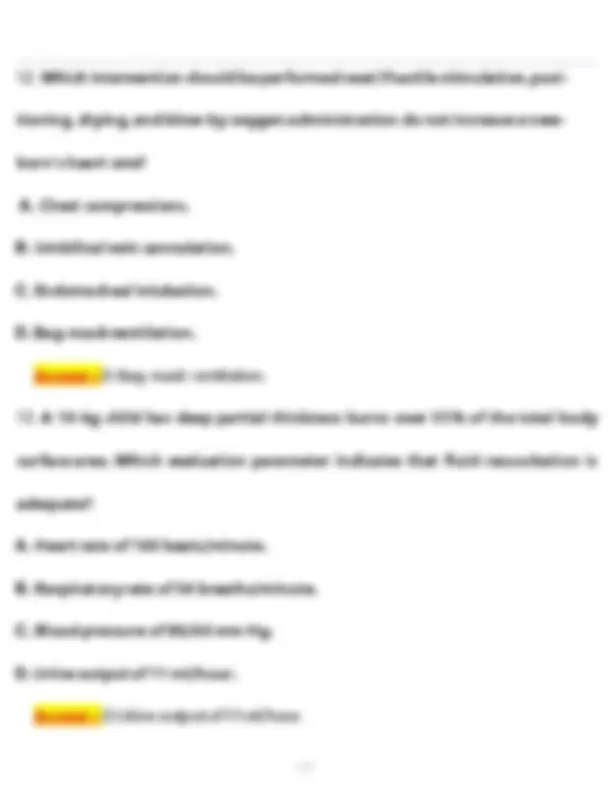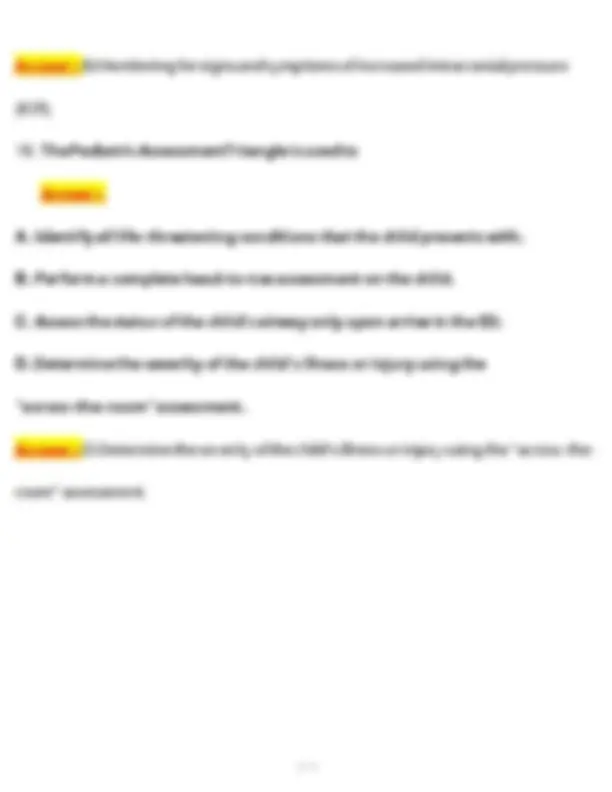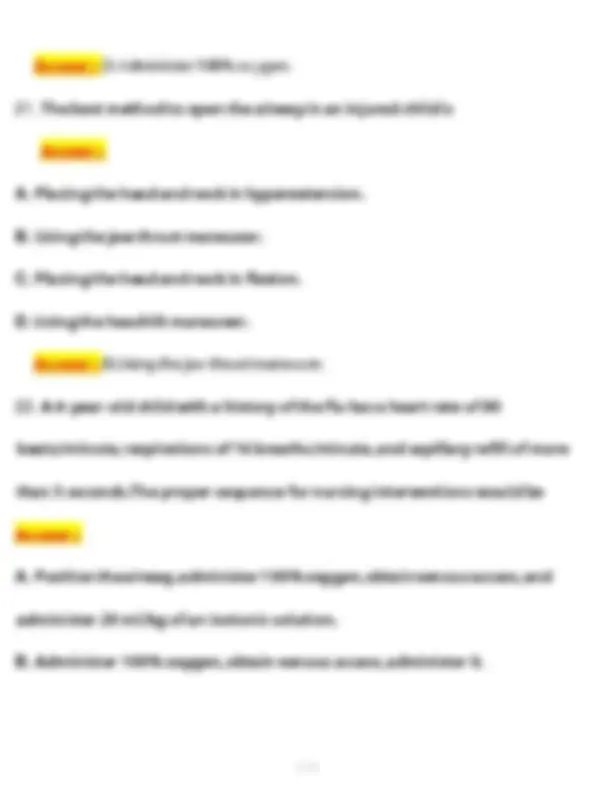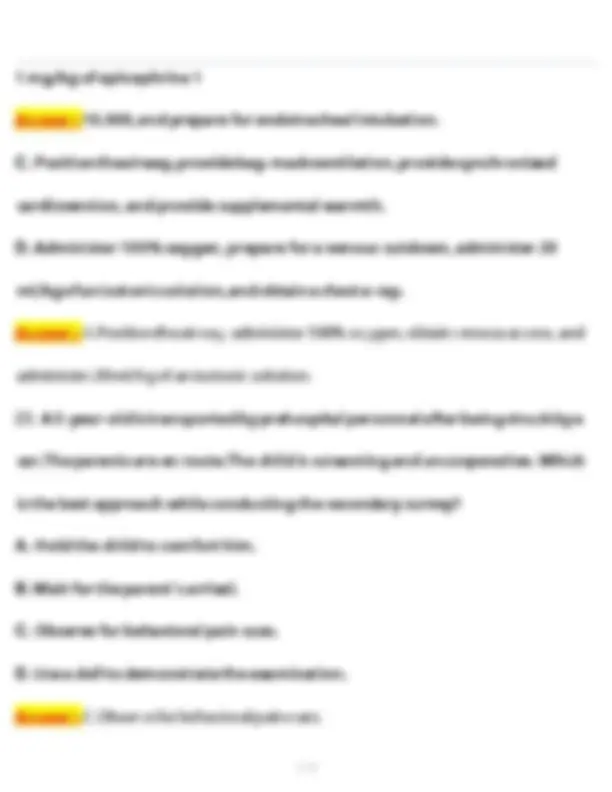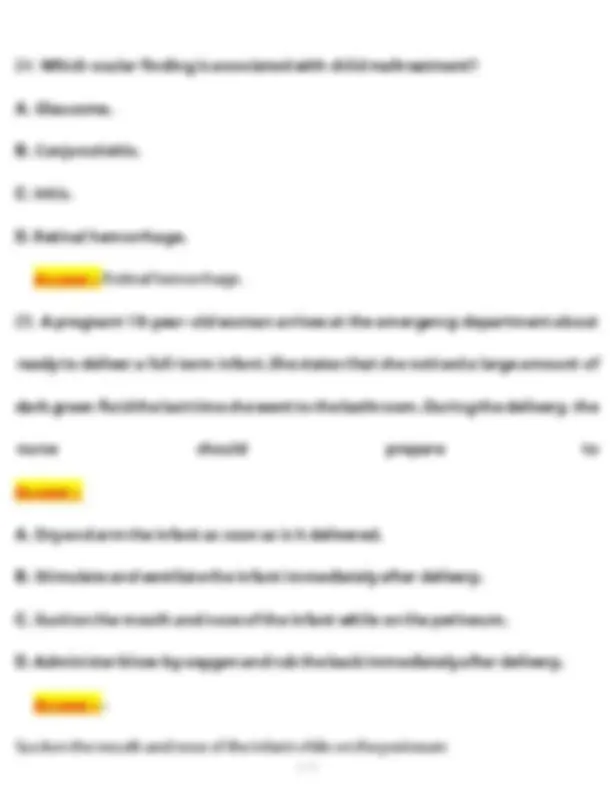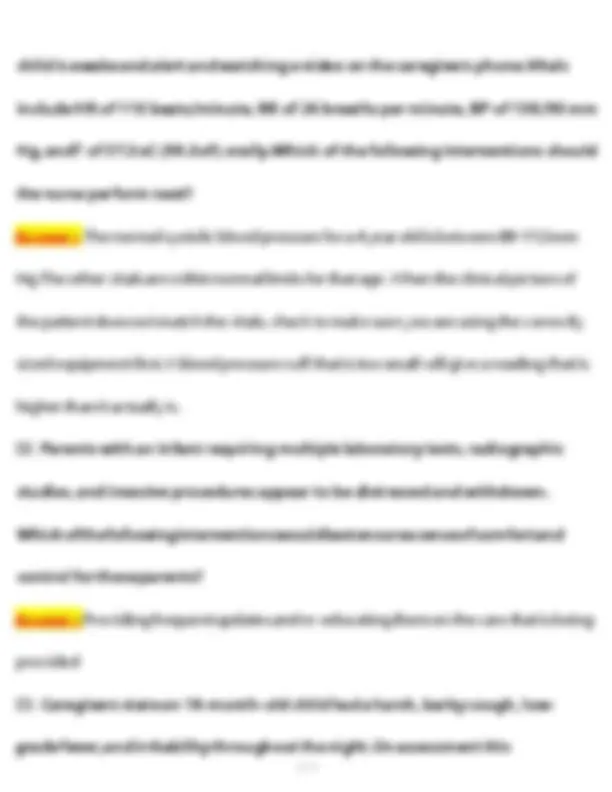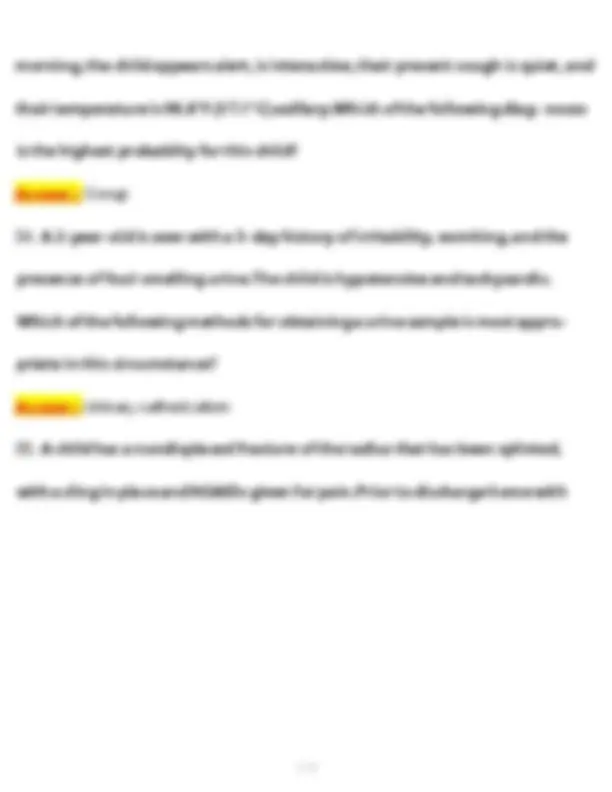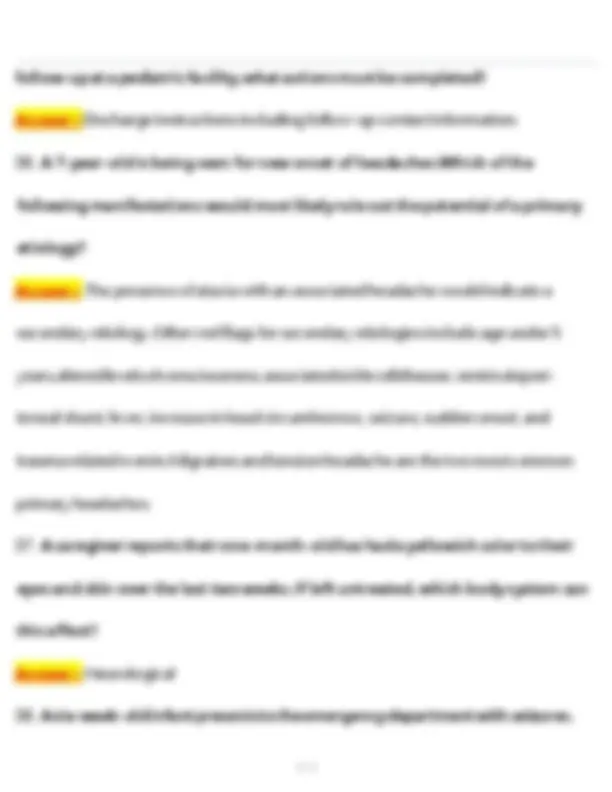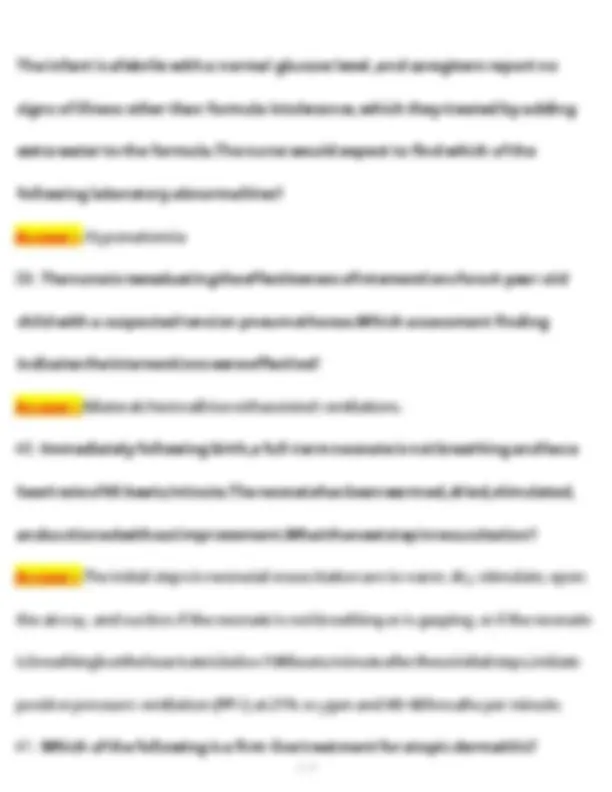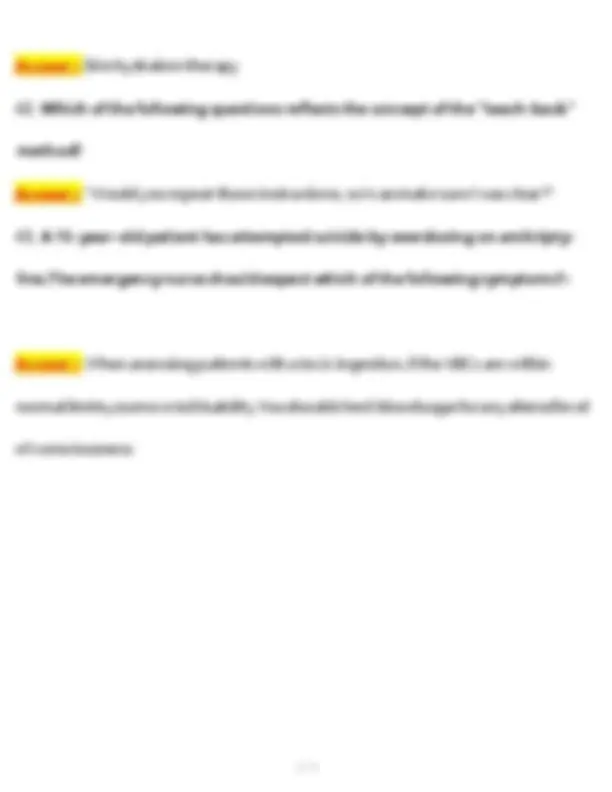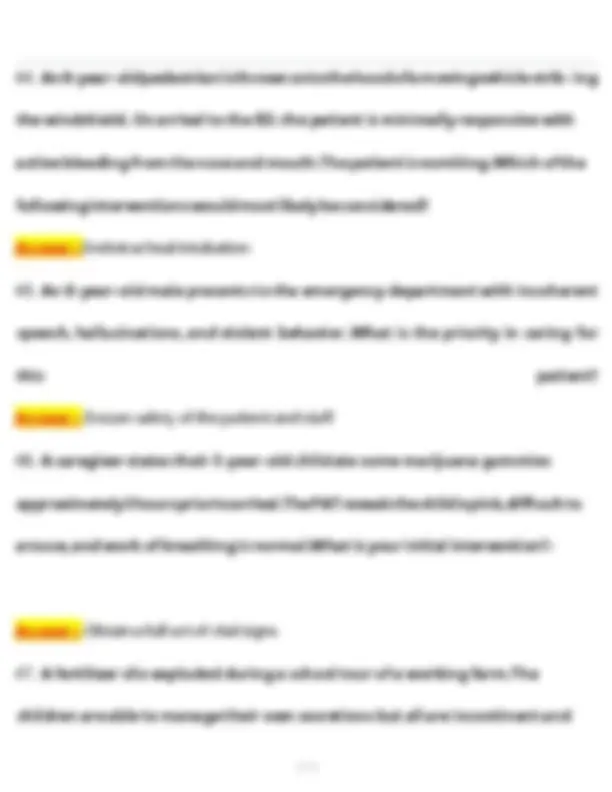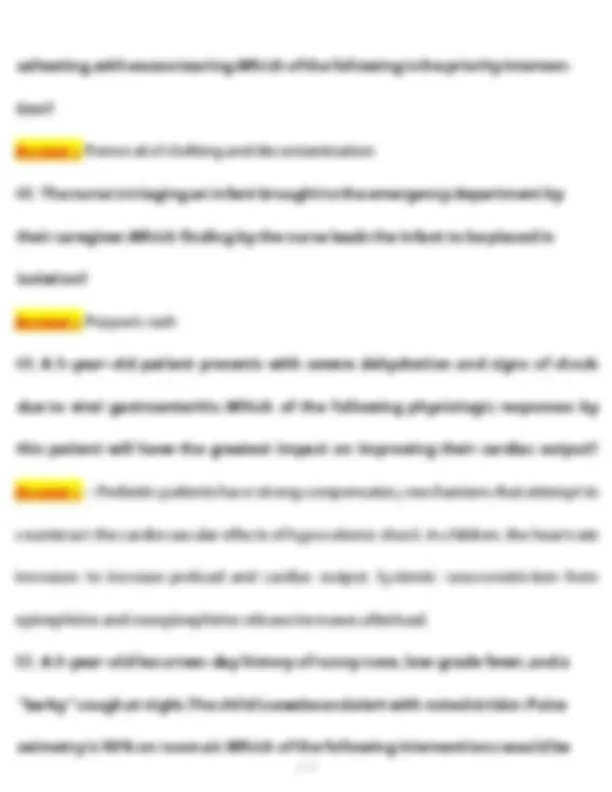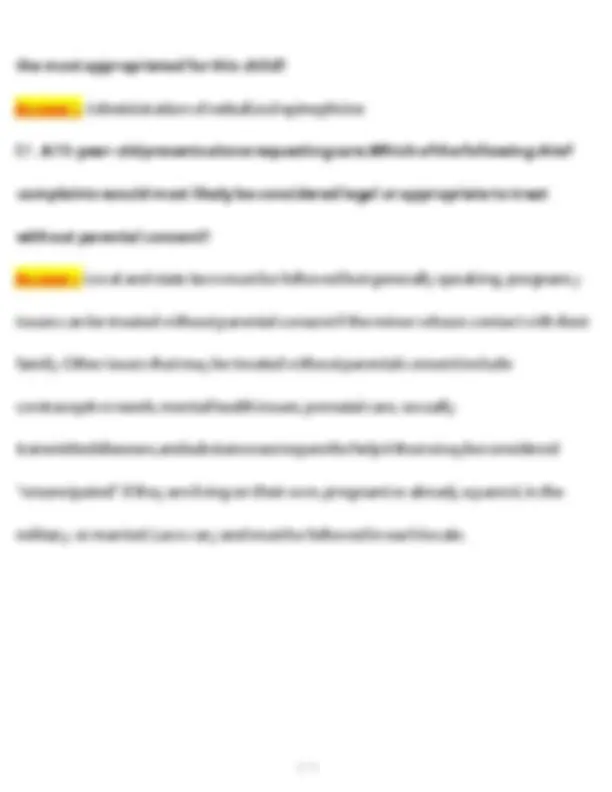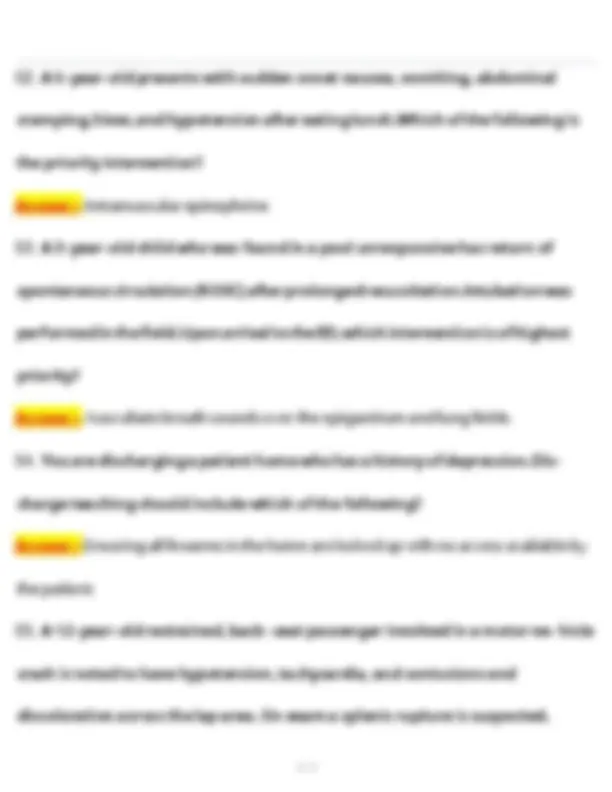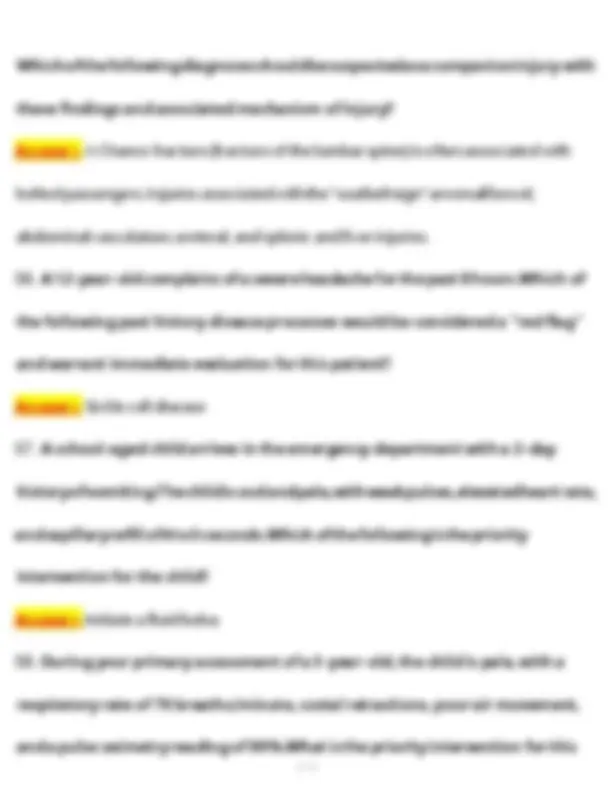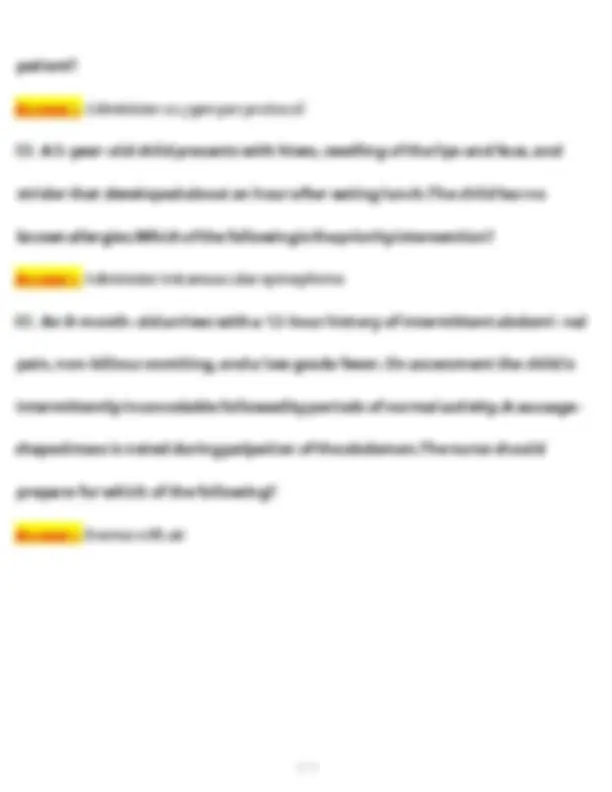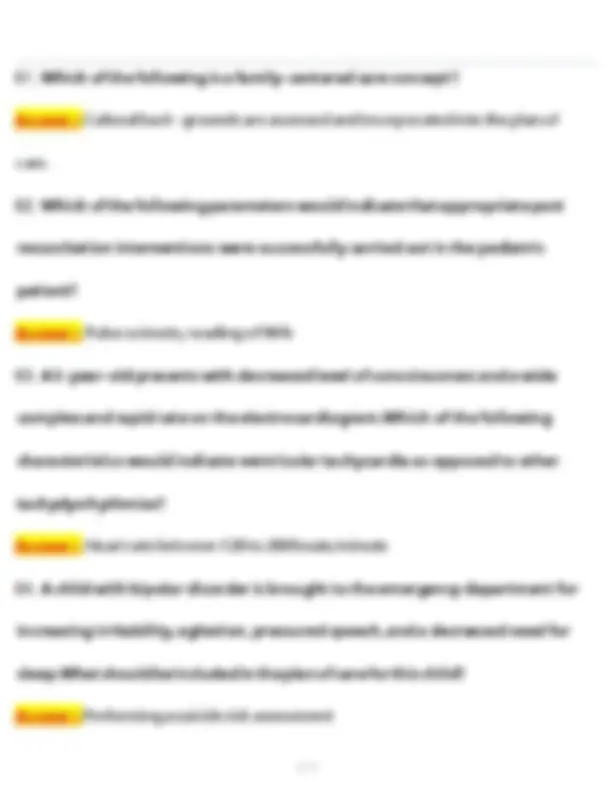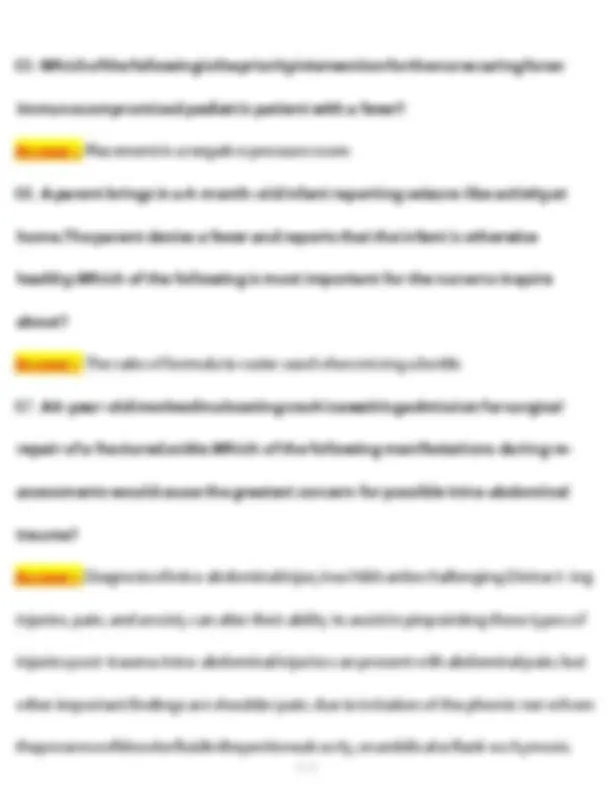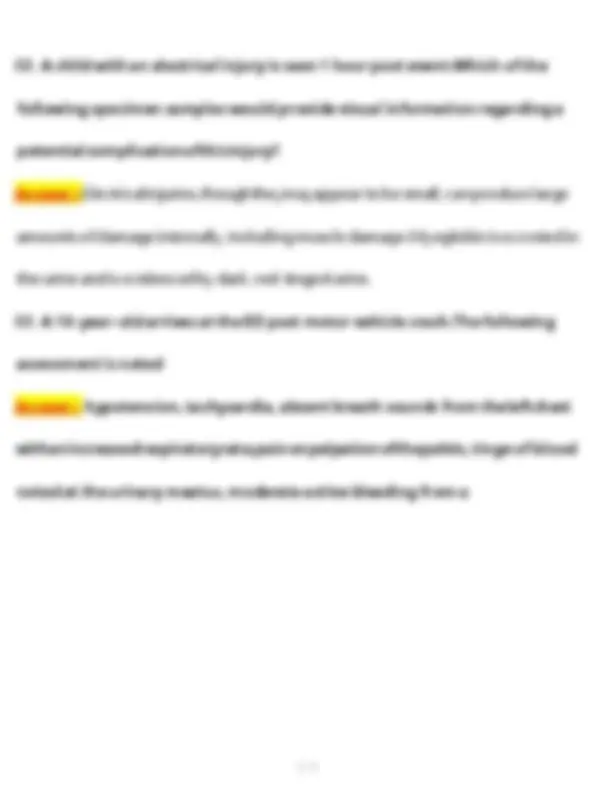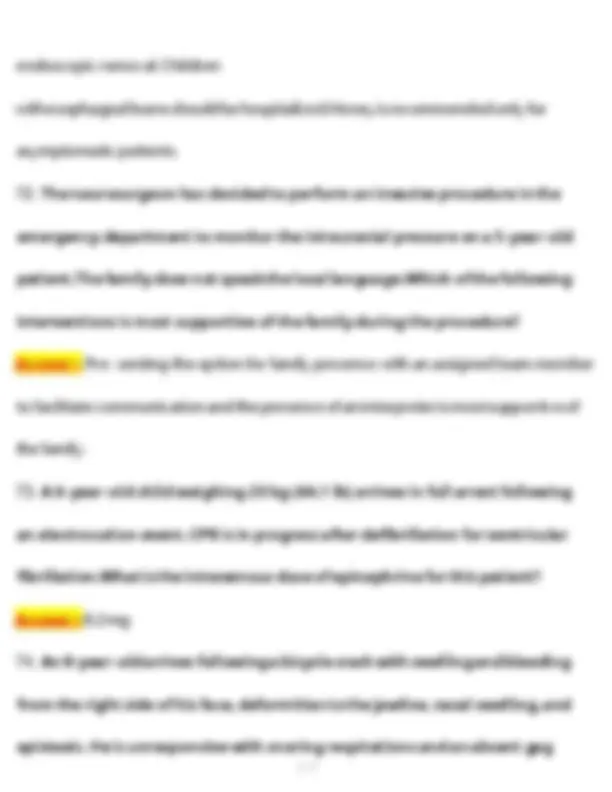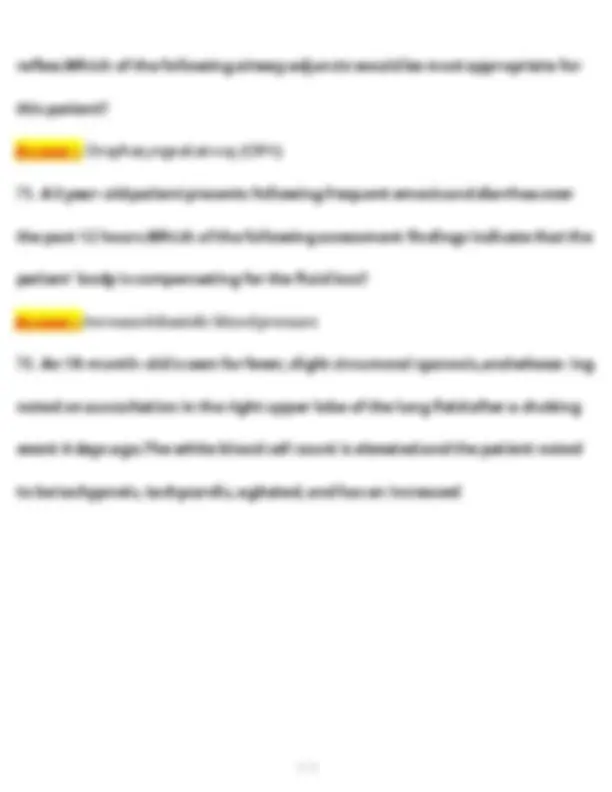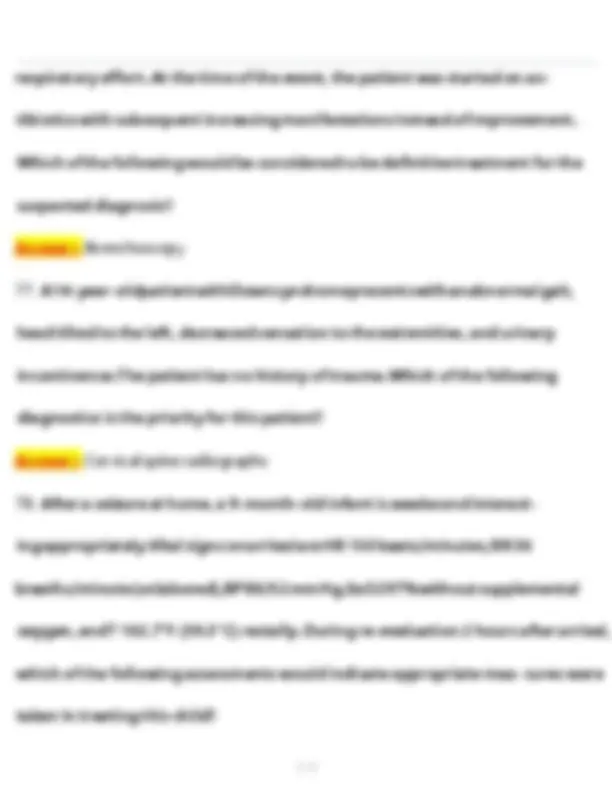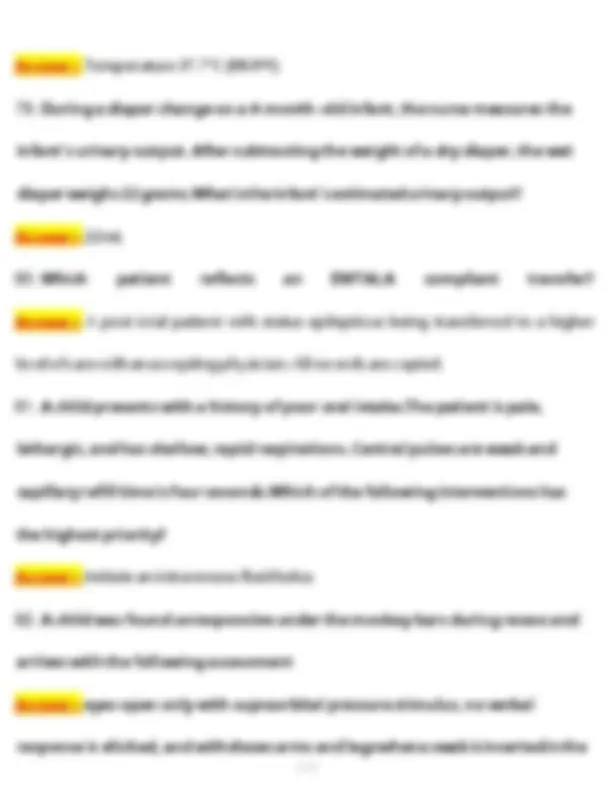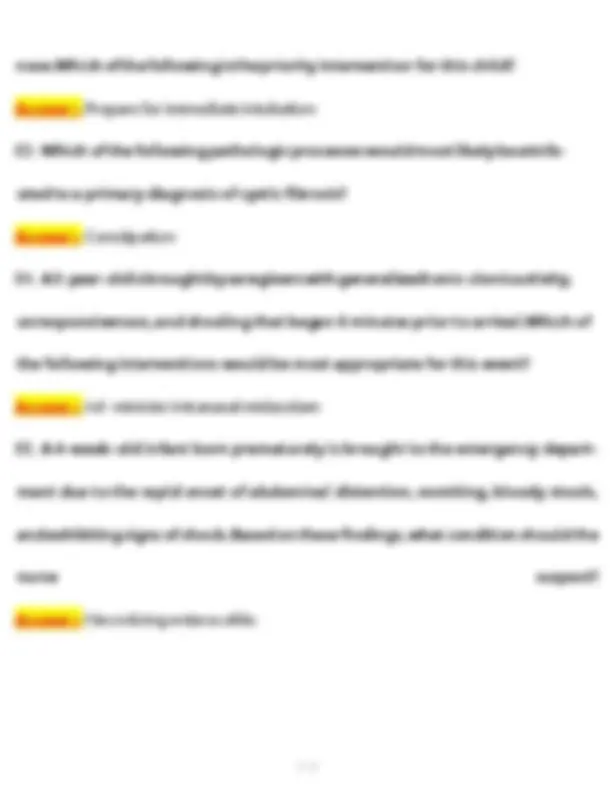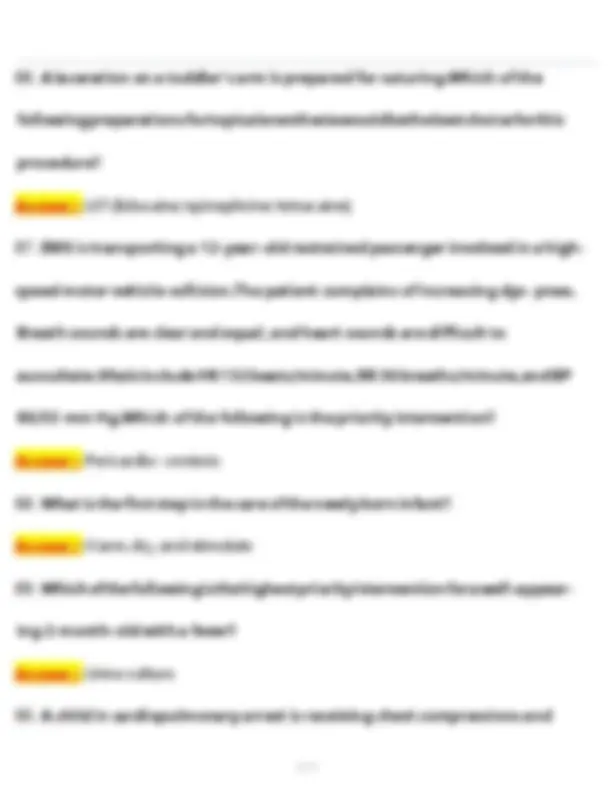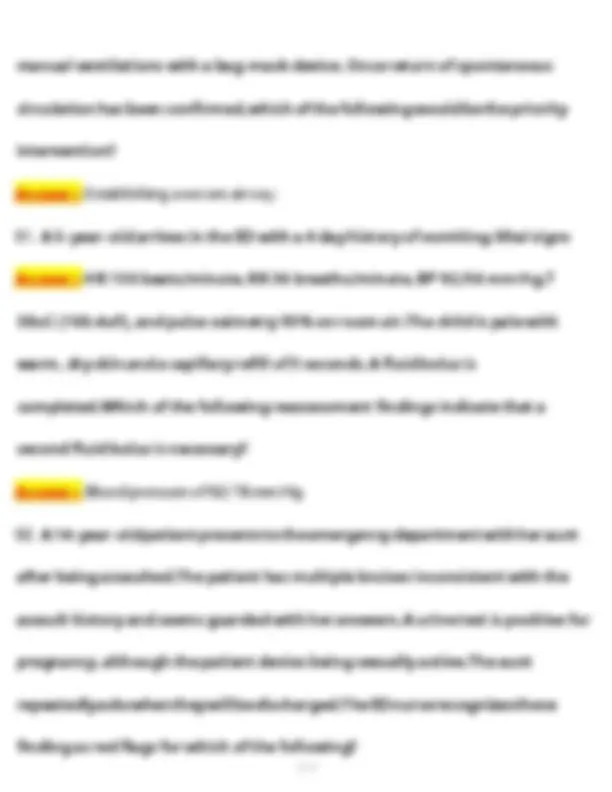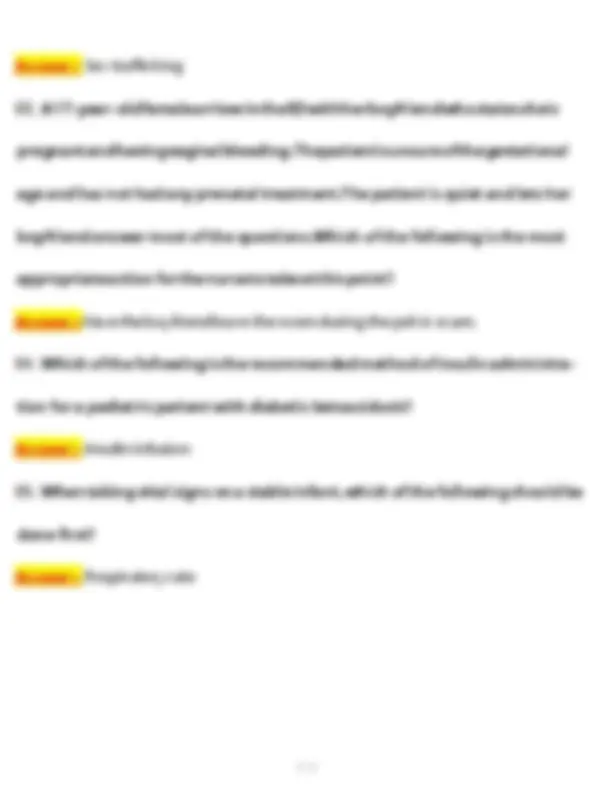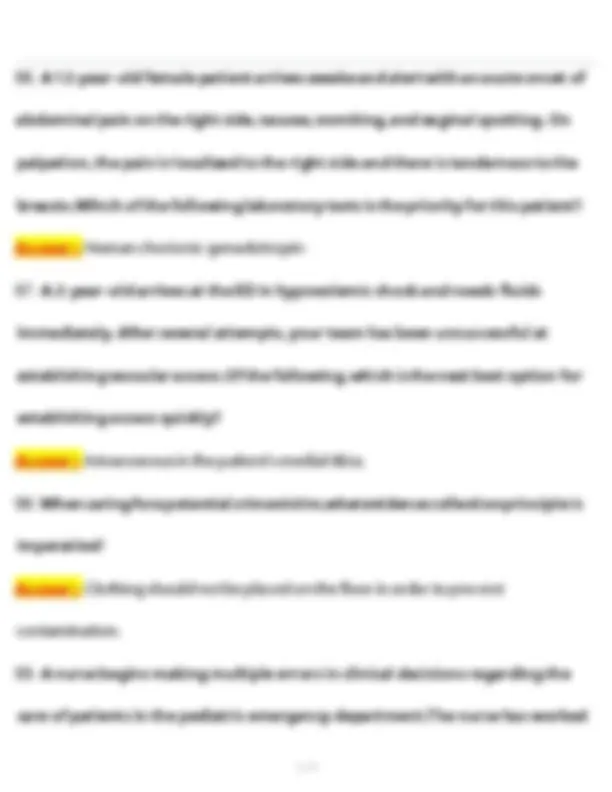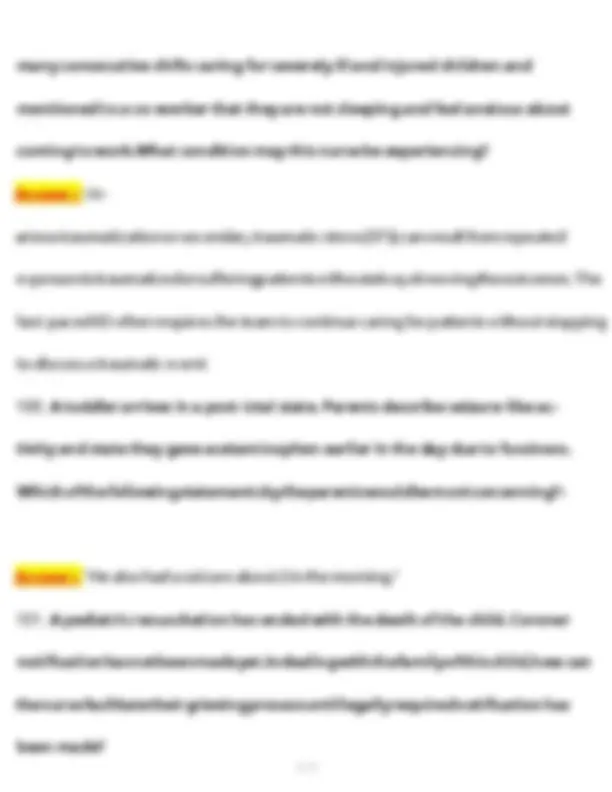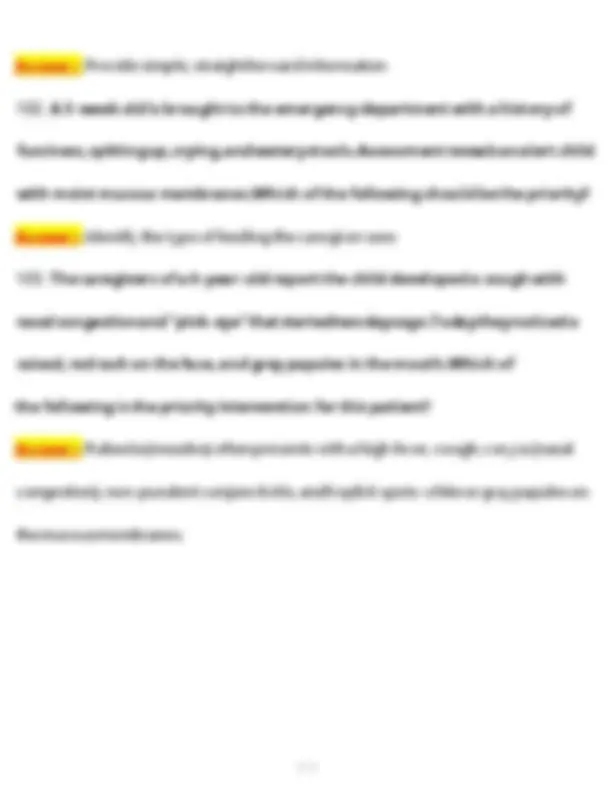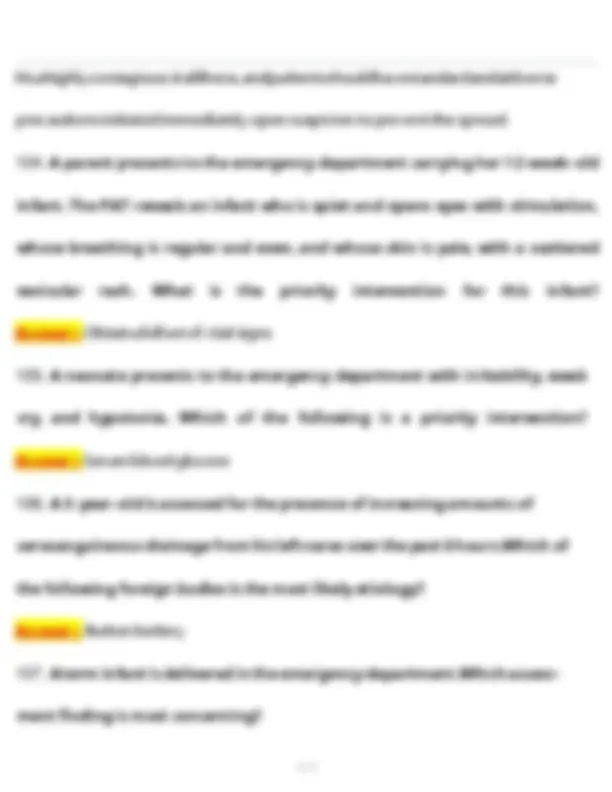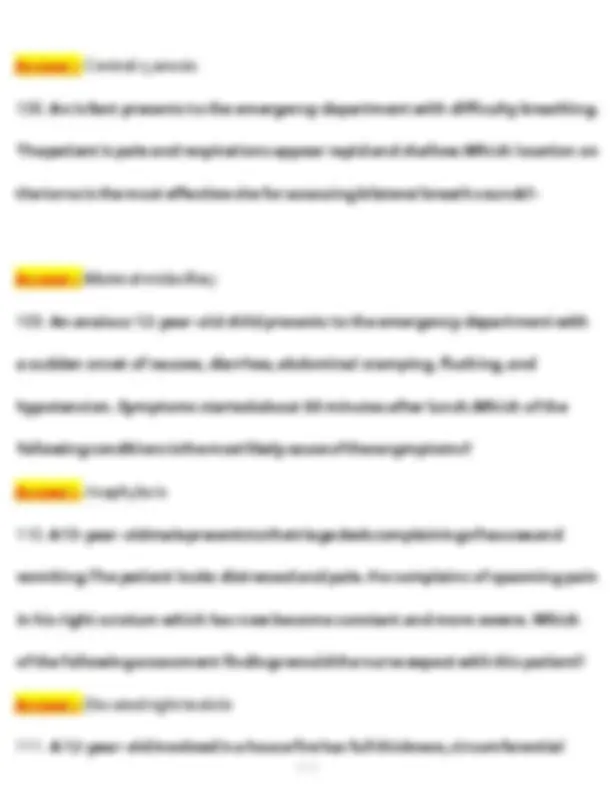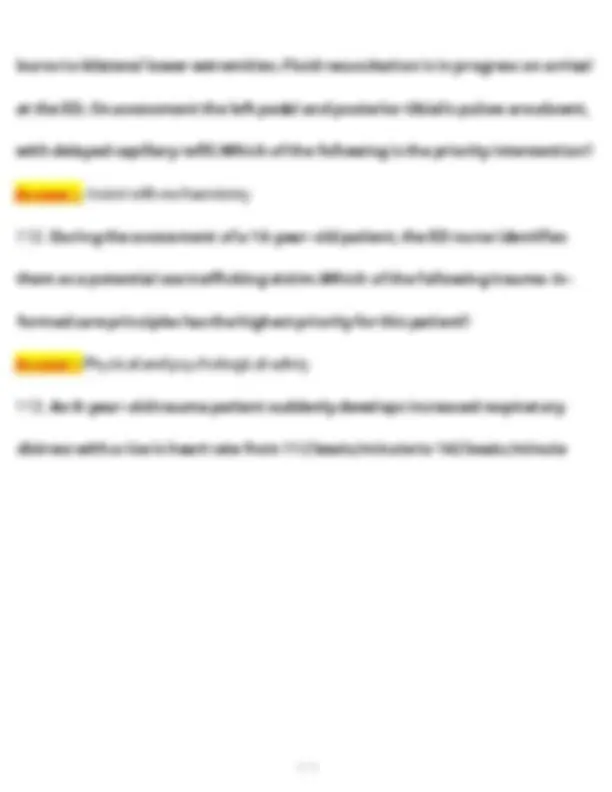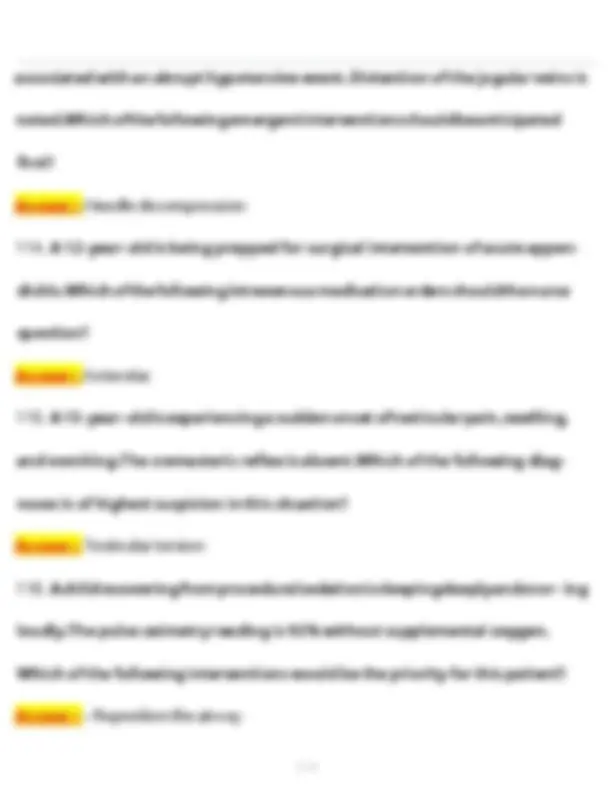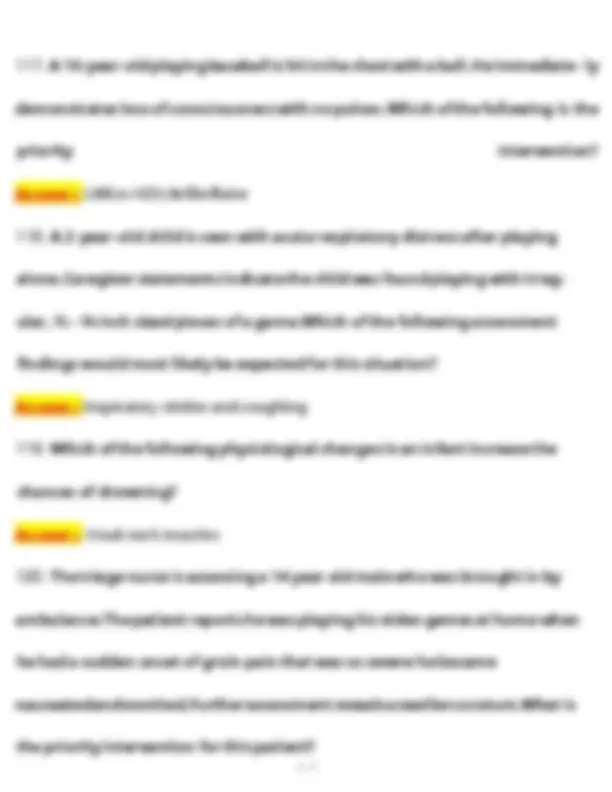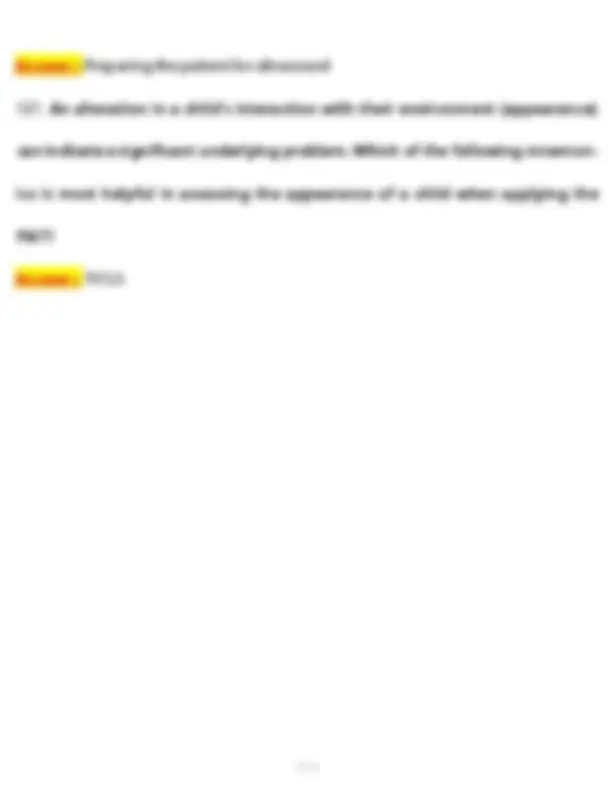Download ENPC Exam Questions and Answers: Pediatric Emergency Care Study Guide and more Exams Personal Health in PDF only on Docsity!
ENPC Test Questions 6th Edition QUESTIONS AND
ANSWERS 100%- SOLVED Newest
- An |unresponsive |2-year-old |child |was |found |by |his |mother |with |a |bottle |labeled |"Elavil | 50 |mg" |by |his |side.|Which |piece |of |information |is |important |to |obtain |from |his |mother? A. The |size |of |the |medication |bottle. B. The |expiration |date |of |the |medication. C. The |number |of |pills |left |in |the |bottle. D. The |person |for |whom |the |medication |was |prescribe.
Answer> |C.|The |number |of |pills |left |in |the |bottle.
- A|nurse |providing|crisis |intervention|to|the|family|of |a|seriously |ill|child|can |best |keep |the |family |informed |of |the |child's |condition |by
A. Placing |them |in |a |secluded |room. B. Referring |to |their |child |as |"the |patient". C. Telling |the |family |how |they |should |feel. D. Appointing |one |staff |member |to |communicate |with |them. Answer> |D.|Appointing |one |staff |member |to |communicate |with |them.
- A |16-month-old |child |was |an |unrestrained |front |seat |passenger |in |a |motor |vehicle |crash.|The |chest |x-ray |reveals |multiple |rib |fractures.|These |findings |suggest |what |type |of |injury? A. Minor |surface |injury. B. Significant |underlying |injury. C. Significant |surface |injury. D. Minor |underlying |injury. Answer> |B.|Significant |underlying |injury.
|of |the |procedure, |you |tell |him
A. "Young |people |your |age |have |questions |about |getting |stitches.|What |are |your |questions?" B. "Don't |cry |while |you |are |getting |the |stitches. |Be |brave |like |a |man." C. "You |will |probably |receive | 10 |stitches.|Do |you |have |any |questions |before |we |restrain |you?" D. "Does|your |cut |hurt?|Would |you |like |your |mommy |to |hold |you?" Answer>|A.|"Young |people |your |age |have |questions |about |getting |stitches.|What |are |your |questions?"
- What |is |the |preferred |sit |for |intraosseous |access |in |the |infant? A. Lateral |malleolus B. Iliac |crest C. Proximal |femur D. Anteromedial |tibia Answer> |D.|Anteromedial |tibia
- An |important |consideration |in |the |assessment |of |pain |for |an |adolescent |patient |is |that |they
A. Dopamine |and |sodium |bicarbonate. B. Epinephrine |and |glucose. C. Naloxone |and |lidocaine. D. Pentothal |and |vecuronium. Answer> |B.|Epinephrine |and |glucose.
- A |20-day-old |infant |has |a |1-week |history |of |not |eating |well.|The |infant |has |a |weak |cry |and |is |jittery.|Which |laboratory |test |is |indicated? A. Arterial |blood |gas. B. Finger-stick |glucose. C. Complete |blood |count |with |differential. D. Toxicology|screen. Answer>|B.|Finger-stick |glucose.
- Which |intervention |should |be |performed |next |if |tactile |stimulation, |posi- |tioning, |drying, |and |blow-by |oxygen |administration |do |not |increase |a |new- |born's |heart |rate? A. Chest |compressions. B. Umbilical |vein |cannulation. C. Endotracheal |intubation. D. Bag-mask |ventilation. Answer> |D.|Bag-mask |ventilation.
- A |10-kg |child |has |deep |partial-thickness |burns |over |35% |of |the |total |body |surface |area. |Which |evaluation |parameter |indicates |that |fluid |resuscitation |is |adequate? A. Heart |rate |of | 160 |beats/minute. B. Respiratory |rate |of | 34 |breaths/minute. C. Blood |pressure |of |80/60 |mm |Hg. D. Urine |output |of | 11 |ml/hour. Answer> |D.|Urine |output |of | 11 |ml/hour.
Answer> |B.|Monitoring |for |signs |and |symptoms |of |increased |intracranial |pressure |(ICP).
- The |Pediatric |Assessment|Triangle |is |used |to Answer> A. Identify |all |life-threatening |conditions |that |the |child |presents |with. B. Perform |a |complete |head-to-toe |assessment |on |the |child. C. Assess |the |status |of |the |child's |airway |only |upon |arrive |in |the |ED. D. Determine |the |severity |of |the |child's |illness |or |injury |using |the "across-the-room" |assessment. Answer>|D.|Determine |the |severity |of |the |child's |illness |or |injury |using |the |"across-the- room" |assessment.
- The |caregivers |of |a |6-year-old |boy |who |is |brought |to |the |emergency |department |for |abdominal |pain |should |first |be |asked Answer> A. "Are |his |immunizations |current?" B. "Has |anything |happened |to |him |at |school |recently?" C. "What |is |the |reason |for |the |child's |visit |and |how |long |has |he |been |ill?" D. "Has |he |been |complaining |of |a |sore |throat |or |earache?" Answer> |C.|"What |is |the |reason |for |the |child's |visit |and |how |long |has |he |been |ill?"
- A|9-month-old|infant|is|crying|loudly|through|the|nursing|assessment,|and |the |caregiver |is |becoming |distraught.|The |nurse |should |ask |the |caregiver |to Answer> A. Read |a |story |to |the |infant. B. Offer |the |infant |a |pacifier. C. Return |when |the |infant |is |consoled. D. Ignore |the |infant's |behavior. Answer> |B.|Offer |the |infant |a |pacifier.
Answer> |D.|Administer |100% |oxygen.
- The |best |method |to |open |the |airway |in |an |injured |child |is Answer> A. Placing |the |head |and |neck |in |hyperextension. B. Using |the |jaw |thrust |maneuver. C. Placing |the |head |and |neck |in |flexion. D. Using |the |head |tilt |maneuver. Answer> |B.|Using |the |jaw |thrust |maneuver.
- A |4-year-old |child |with |a |history |of |the |flu |has |a |heart |rate |of | 80 |beats/minute, |respirations |of | 16 |breaths/minute, |and |capillary |refill |of |more |than | 3 |seconds.|The |proper |sequence |for |nursing |interventions |would |be Answer> A. Position |the |airway,|administer |100% |oxygen,|obtain |venous |access,|and |administer | 20 |ml/kg |of |an |isotonic |solution. B. Administer |100% |oxygen, |obtain |venous |access, |administer |0.
1 |mg/kg |of |epinephrine | 1 Answer>10,000, |and |prepare |for |endotracheal |intubation. C. Position|the|airway,|provide |bag-mask|ventilation,|provide |synchronized |cardioversion, |and |provide |supplemental |warmth. D. Administer |100% |oxygen, |prepare |for |a |venous |cutdown, |administer | 20 |ml/kg |of |an |isotonic |solution,|and |obtain |a |chest |x-ray. Answer>|A.|Position |the |airway, |administer |100% |oxygen, |obtain |venous |access, |and |administer | 20 |ml/kg |of |an |isotonic |solution.
- A |3-year-old |is |transported |by |prehospital |personnel |after |being |struck |by |a |car.|The |parents |are |en |route.|The |child |is |screaming |and |uncooperative. |Which |is |the |best |approach |while |conducting |the |secondary |survey? A. Hold |the |child |to |comfort |him. B. Wait |for |the |parent's |arrival. C. Observe |for |behavioral |pain |cues. D. Use |a |doll |to |demonstrate |the |examination. Answer> |C.|Observe |for |behavioral |pain |cues.
- A |4-year-old |presents |with |vomiting, |lethargy, |frequent |urination, |weight |loss, |and |dry |mucous |membranes.|Vital |signs |reveal |deep |respirations |at | 44 |breaths |per |minute,|BP |of |70/44|mm |Hg,|and|HR |of | 144 |beats |per |minute.|Which |of |the |following |laboratory |values |would |be |most |expected |in |this |child? Answer> |Low |pH |level
- A |teenager |presents |to |the |ED |for |evaluation |of |pain |with |deep |inspiration. |The |pain |was |a |sudden |onset |after |running |track |at |school.|While |obtaining |the |history, |the |patient |states |that |they |have |Marfan |Syndrome.|What |would |be |a |priority |triage |question |based |on |this |information? Answer> |"Have |you |ever |had |a |pneumothorax?"
- A |6-week-old |is |brought |to |the |emergency |department |by |the |caregivers |for |poor |feeding, |listlessness,|and |fever. |Assessment |reveals |a |crying |infant, |HR | 160 |beats/minute, |RR | 52 |breaths/minute, |rectal |temperature |of |96.0 |F |(35.5 |C), |and |a |bulging |anterior |fontanel. |Capillary |refill |is | 4 |seconds. |Based |on |these |findings |what |is |the |most |likely |diagnostic |test |the |nurse |should |anticipate? Answer> |Lumbar |puncture
- A |6-month-old |arrives |with |swelling |to |the |left |thigh. |Caregivers |deny |any |traumatic |event.|Assessment |findings |include |a |patient |who|is|active |and|alert, |in |the |10th |percentile |for|length,|and |has |blue-grey |sclera.|Radiographs |reveal |a |midshaft |fracture |of |the |left |femur.|Which |of |the |following |is |the |most |likely |cause? Answer> |Osteogenesis |imperfecta
- Which |of |the |following |is |considered |a |"red |flag" |when |triaging |a |pediatric |patient? Answer> |A |3-week-old |with |a |temperature |of |38.2°C |(100.7°F)
- A |4-year-old |patient |is |being |assessed |for |a |foreign |body |in |the |nose.|The
morning, |the |child |appears |alert, |is |interactive, |their |present |cough |is |quiet, |and |their |temperature |is |98.8°F |(37.1°C) |axillary.|Which |of |the |following |diag- |noses |is |the |highest |probablity |for |this |child? Answer> |Croup
- A |2-year-old |is |seen |with |a |3-day |history |of |irritability, |vomiting, |and |the |presence |of |foul-smelling |urine.|The |child |is |hypotensive |and |tachycardic. |Which |of |the |following |methods |for |obtaining |a |urine |sample |is |most |appro- |priate |in |this |circumstance? Answer> |Urinary |catherization
- A |child |has |a |nondisplaced |fracture |of |the |radius |that |has |been |splinted, |with |a |sling |in |place |and |NSAIDs |given |for |pain. |Prior |to |discharge |home |with
follow-up |at |a |pediatric |facility,|what |actions |must |be |completed? Answer>|Discharge |instructions |including |follow-up |contact |information.
- A |7-year-old |is |being |seen |for |new |onset |of |headaches.|Which |of |the |following |manifestations |would |most |likely |rule |out |the |potential |of |a |primary |etiology? Answer> |The |presence |of |ataxia |with |an |associated |headache |would |indicate |a |secondary |etiology. |Other |red |flags |for |secondary |etiologies |include |age |under | 5 |years,|altered |levels|of |consciousness,|associated|sickle|cell|disease,|ventriculoperi- |toneal |shunt, |fever, |increase |in |head |circumference, |seizure, |sudden |onset, |and |trauma |related |events.|Migraines |and |tension |headache |are |the |two |most |common |primary |headaches.
- A |caregiver |reports |their |one-month-old |has |had |a |yellowish |color |to |their |eyes |and |skin |over |the |last |two |weeks. |If |left |untreated, |which |body |system |can |this |affect? Answer> |Neurological
- A |six-week-old |infant |presents |to|the |emergency |department |with |seizures.

